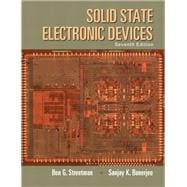Solid State Electronic Devices is intended for undergraduate electrical engineering students or for practicing engineers and scientists interested in updating their understanding of modern electronics
¿
One of the most widely used introductory books on semiconductor materials, physics, devices and technology, Solid State Electronic Devices aims to: 1) develop basic semiconductor physics concepts, so students can better understand current and future devices; and 2) provide a sound understanding of current semiconductor devices and technology, so that their applications to electronic and optoelectronic circuits and systems can be appreciated. Students are brought to a level of understanding that will enable them to read much of the current literature on new devices and applications.
¿¿
Teaching and Learning Experience
This program will provide a better teaching and learning experience–for you and your students. It will help:
- Provide a Sound Understanding of Current Semiconductor Devices: With this background, students will be able to see how their applications to electronic and optoelectronic circuits and systems are meaningful.
- Incorporate the Basics of Semiconductor Materials and Conduction Processes in Solids: Most of the commonly used semiconductor terms and concepts are introduced and related to a broad range of devices.
- Develop Basic Semiconductor Physics Concepts: With this background, students will be better able to understand current and future devices.








